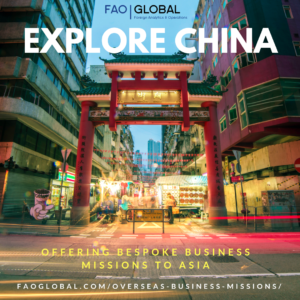
Augmented Reality & Virtual Reality (AR/VR) present unlimited possibilities for how to view the world. A technology explosion in Asia is presenting some interesting opportunities. Over the last year, Brandon Hughes was fortunate enough to attend the China High-Tech and Investment Fair in Shenzhen, the International Export & Investment Fair in Xiamen, the Consumer Electronic Show in Las Vegas. Brandon also recently talked with companies at Hong Kong’s RISE conference. Intermixed throughout, Brandon has talked with industry experts, sales teams, investors, and engineers on the subject matter. Below are a few observations of the AR/VR space in the Asian marketplace.
3 Key Takeaways:
1. There is No Dominant Market Leader in Asia –
The current use and potential for VR/AR applications is tremendous. Even through there is some demand globally, FAO Global has not yet seen a clear market leader. Many of the firms we have talked to have all captured a few big names, but by and large, have limited clients in total. While VR/AR solutions function more like marketing purposes, these firms can be leveraged and created side-by-side with developers as an integrated part of the design or sales process. This market fragmentation offers opportunities to western firms looking to expand abroad. International firms broken up geographically are all potential customers. If a company can localize their content, then every market is now a possibility.
2. ROI is Difficult to Articulate –
Artificial and Virtual Reality is still relatively new and the Return on Investment (ROI) is hard to articulate for potential customers who consider AR/VR solutions as a novelty, not a necessity. Most see AV/VR as a marketing gimmick or a design tool, but not the sales powerhouse it can be. If ROI became more quantifiable, ROI articulation would be at the crux of market leadership.
What if a commercial developer could pre-sell their units 5-10% faster (or have a higher rate of pre-sell) on a $100 million-dollar development? Could that business use that extra time or $10,000,000 for something else? How would smart cities be developed if your operations teams could test them in VR first before any manufacturing or heavy IP begins? Can that cost savings be quantified? What about airplanes, cars, hotels, etc.? The possibilities are endless, but VR/AR companies need to understand the target market, industry trends, and be able to quantify how their fees will be regained.
3. Practical Solutions for Real World Problems
One of the most useful examples of VR/AR FAO Global has seen came from a group of Chinese start-ups in Shenzhen. They created augmented reality glasses that would enable a mechanic to dissect and disassemble a piece of machinery. Imagine, a developer can see each of the new designs before any money is spent to renovate a new commercial purchase. There are many real-world problems that could be solved but need to be pursued. Rather than focus on capabilities, firms should pursue solutions and value brought to the company.
Recommendations for AV/VR companies
Think Globally – The cost of AR/VR is not an easy decision if the ROI is not clear. It is crucial to view your clients as not only local, but global. It’s imperative that a clear and articulate reason to buy is presented. Expanding the market size expands the pool of customers willing and able to pay.
Pursue Non-traditional Avenues – Do this by focusing on new segments. This could be international hotel brands, shopping malls, automotive or aviation firms, hospitals, and so forth. If one company from that sector is using it, then immediately pursue others.
Do your market research – Attend the conferences where your buyers are, not only your peers. Look at regional opportunities to build your brand across a global stage. Understand what a 3% cost savings means to a business life cycle. Know how long it takes to design a cabin interior or sell commercial units. These are the little details that make a sale.
About the Author
Brandon Hughes is a U.S. businessman and China Strategist with over a decade of experience focused on emerging markets. He is currently the Founder/ CEO, and Principle consultant at FAO Global which provides bespoke data analysis and management consulting services to firms investing & operating in China & emerging markets. Brandon brings over a decade of experience working in international markets from the public, non-profit, and private sectors. He holds an L.L.M. from Tsinghua University (Asia#1) and a B.S. in International Business from UNLV. He is currently completing a joint MBA through Columbia University, London Business School, & Hong Kong University.
Plan your Global Strategy with FAO Global
Building a global strategy requires a unique understanding of localization, adaptive organizational structure, geopolitics, and competition. FAO Global incorporates more than a decade of preparing organizations for international ventures in the public, private, and non-profit sectors.

FAO Global is Your International Partner
FAO Global provides China Consulting services, USA Market Entry, tailored business missions, and many more services to build bridges between the U.S. and emerging markets. Contact us to discuss your next international business venture or investment.

